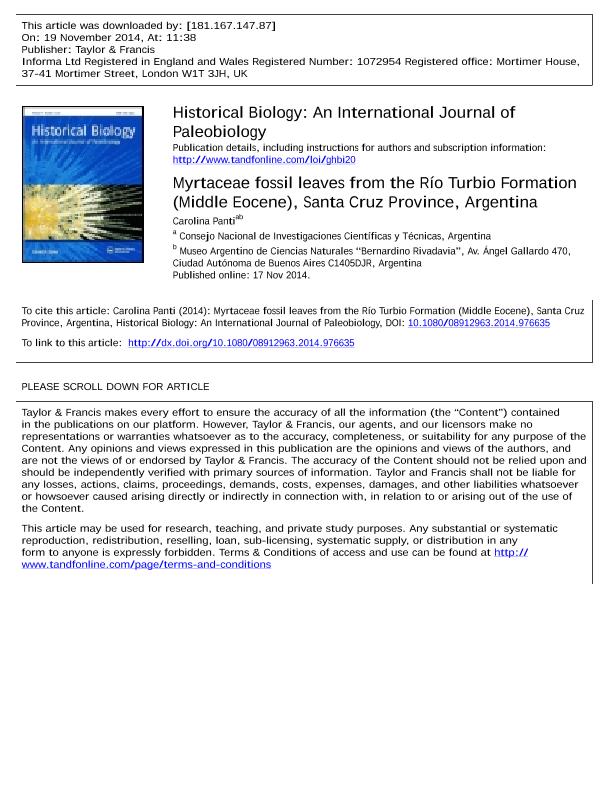Artículo
Myrtaceae fossil leaves from the Río Turbio Formation (Middle Eocene), Santa Cruz Province, Argentina
Fecha de publicación:
11/2014
Editorial:
Taylor & Francis
Revista:
Historical Biology
ISSN:
0891-2963
Idioma:
Inglés
Tipo de recurso:
Artículo publicado
Clasificación temática:
Resumen
Myrtaceae, the gum tree family, is a large angiosperm clade of 5671 species mostly distributed in tropical and subtropical regions of the world. In the southernmost tip of South America (Santa Cruz province) where the fossils analysed in this study come from (Rı´o Turbio Formation), this family is virtually absent and the extant vegetation is largely dominated by deciduous Nothofagus pumilio and Nothofagus antarctica. During the early Paleogene, however, the Myrtaceae were an important element in southern Patagonian floras. Here, we report and describe ten taxa related to the extant genera Eugenia, Myrcia, Psidium, Myrcianthes and possible Eucalyptus and Campomanesia. The presence of a high diversity of Myrtaceae during the Eocene in one of the southernmost regions of the world could be thought as unusual. However, during this period of time (45 Ma), a number of other tropical lineages also reached these high latitudes probably as a consequence a warming climatic trend. In fact, through the Paleocene–Early Eocene interval, climatic conditions were the warmest of the Cenozoic. After this period of time, a progressive decline in temperature forced the migration of megathermal elements towards lower latitudes and, at the same time, led to the expansion of forest dominated by Nothofagus which predominate the region today.
Palabras clave:
Myrtaceae
,
Fossil
,
Río Turbio
,
Argentina
Archivos asociados
Licencia
Identificadores
Colecciones
Articulos(MACNBR)
Articulos de MUSEO ARG.DE CS.NAT "BERNARDINO RIVADAVIA"
Articulos de MUSEO ARG.DE CS.NAT "BERNARDINO RIVADAVIA"
Citación
Panti, Carolina; Myrtaceae fossil leaves from the Río Turbio Formation (Middle Eocene), Santa Cruz Province, Argentina; Taylor & Francis; Historical Biology; 28; 4; 11-2014; 459-469
Compartir
Altmétricas




